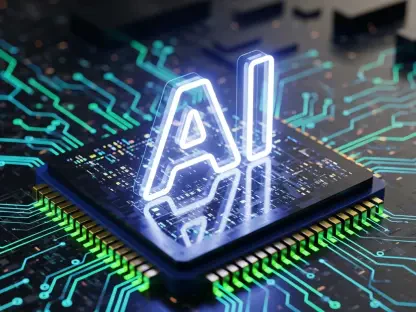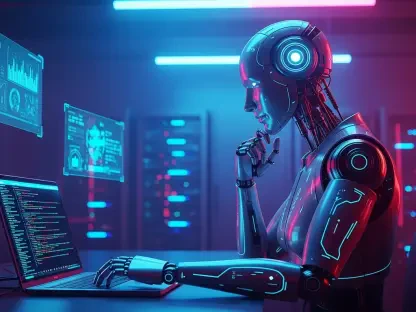Artificial intelligence (AI) is revolutionizing numerous industries, and software development is no exception. With capabilities extending far beyond simple automation, AI is enhancing productivity, creativity, and efficiency in ways previously unimagined. Developers now find themselves at an exciting crossroads where collaborative interaction with intelligent systems is not just a possibility but a growing reality. From automating mundane tasks to enabling advanced system designs, AI is reshaping the software development landscape in profound and unprecedented ways.
The Transformative Potential of AI in Software Development
AI is ushering in a new era for software development by dramatically increasing productivity. One of the primary benefits is the automation of repetitive tasks, such as code reviews and testing processes. Tools like GitHub Copilot use large language models (LLMs) to offer real-time coding assistance, generate code snippets, catch bugs, and suggest optimizations. This leap facilitates a more streamlined and efficient development cycle. Moreover, AI-powered coding-centric chatbots can translate natural language descriptions into executable code. This capability allows developers to move from idea to implementation more swiftly, saving both time and effort.
AI tools are increasingly sophisticated, fostering a collaborative relationship between human developers and intelligent systems rather than merely replacing human capacities. As these tools evolve, they are becoming more adept at understanding context and providing more nuanced suggestions, thereby improving overall code quality and reducing the likelihood of errors. Additionally, AI-driven tools can help with complex tasks like performance optimization and security enhancements, areas traditionally labor-intensive and error-prone. This collaborative synergy between AI and developers is setting new benchmarks in productivity and code quality.
Shifting Developer Roles: From Syntax to Solving Real-World Problems
As AI handles more routine coding tasks, the role of developers is evolving. Developers are transitioning from the meticulous crafting of syntax to curating and guiding AI systems. This shift enables them to focus on creativity, system design, and solving more complex, real-world problems. Artem Kroupenev, Vice President of Strategy at Augury, emphasizes that this change allows developers to serve as curators, guiding AI as it generates and refines solutions. By re-orienting their expertise towards more valuable and intellectually stimulating activities, developers can leverage AI to enhance their problem-solving strategies and drive innovation.
This newfound freedom allows developers to engage more deeply with the broader architecture of their projects. They can spend more time on design considerations, user experience improvements, and other aspects that require human intuition and creativity. Furthermore, as developers become more adept at working alongside AI, they will likely uncover new ways to innovate and push the boundaries of what’s possible in software development. This evolution from coding to curating opens up exciting possibilities for what’s next in the field, positioning developers as visionaries who harness AI to bring their most ambitious ideas to life.
Capabilities and Limitations of Current AI Tools
While AI tools like GitHub Copilot represent a notable advancement, they come with their own set of limitations. These tools excel in generating boilerplate code and handling straightforward tasks but struggle with context-rich, complex development work. As Scott Bonneau, Executive Vice President of Product and Operations at Karat, points out, AI tools still face challenges in understanding large codebases and integrating multi-faceted concerns like security, performance, and usability. Developers need to be aware of these limitations to effectively harness AI tools. Understanding where AI can make the most impact while recognizing its current boundaries is crucial for integrating these tools into their workflows productively.
Despite these limitations, the potential benefits of AI tools are immense. They can drastically reduce the time spent on routine tasks, freeing developers to focus on more complex problems. AI can also serve as an excellent learning tool for new developers, providing real-time feedback and suggestions that help them improve their coding skills more quickly. However, it is essential to balance reliance on AI with traditional methods to ensure that the resulting software is robust, secure, and performant. This balance will be key in ensuring the long-term viability and success of AI-enhanced software development practices.
Importance of Customer-Centric AI Applications
For AI to be effective, developers need to focus on areas where it provides the most value to their customers. Kevin Kelly, Director of the AWS Cloud Institute, advises developers to work backward from customer needs to identify areas for AI implementation. This approach ensures that AI applications are not only innovative but also practical and aligned with real-world demands. Such a customer-centric approach guarantees that AI tools enhance user experiences and improve processes in meaningful ways. Developers should aim to apply AI to domains where it can offer substantial value and improve the overall product quality and user satisfaction.
Implementing AI with a strong focus on customer needs also helps to build trust and reliability in AI-driven solutions. When customers see tangible benefits from AI, whether in terms of enhanced functionality, improved performance, or more intuitive user interfaces, they are more likely to adopt and advocate for these technologies. Additionally, understanding customer needs deeply can help developers identify specific pain points that AI can address, leading to more tailored and effective solutions. This customer-centric focus is crucial for driving meaningful innovation and ensuring that AI applications are both impactful and sustainable.
Adhering to Company Policies and Governance
Incorporating AI technologies responsibly requires adherence to company policies and governance frameworks. Organizations must establish clear guidelines for AI adoption to ensure compliance and responsible usage. Developers should align their AI initiatives with these policies to facilitate a smooth integration within their organizational structure. Rob Whiteley, CEO at Coder, underscores the importance of following best practices for AI adoption to maintain alignment with company principles and regulations. This alignment prevents potential pitfalls and ensures that AI adoption is both strategic and ethically sound.
By adhering to established policies and governance frameworks, developers can mitigate risks and protect both their organizations and end users. Clear guidelines help ensure that AI tools are used responsibly, avoiding potential ethical dilemmas and maintaining the integrity of the development process. Moreover, adhering to these frameworks fosters a culture of accountability and continuous improvement, where developers are encouraged to stay updated with the latest best practices and innovations in AI. This structured approach not only facilitates seamless AI integration but also enhances the overall quality and reliability of AI-driven solutions.
Growing Your AI Skills and Knowledge
The rapidly evolving AI landscape demands continuous learning and skill development. For individual developers, gaining hands-on experience with AI tools, such as ChatGPT or Bard/Gemini, is crucial. Understanding the basics of generative AI, transformers, and neural networks is essential for effective implementation. Victoria Myers, Global Head of Talent Attraction at Amdocs, recommends setting clear, measurable learning goals to guide AI skill acquisition. Pursuing certifications from platforms like AWS, Coursera, or Udacity can provide formal recognition of AI proficiency and broaden developers’ expertise in specific areas.
In addition to formal education, practical experience is invaluable. Experimenting with different AI tools and applications helps developers understand their strengths and limitations, enabling them to choose the right tools for specific tasks. Collaborating with peers and participating in AI-focused communities can also provide opportunities for knowledge sharing and staying updated with the latest trends and advancements in AI. As developers build their AI skills, they become better equipped to leverage AI effectively, driving innovation and enhancing their contributions to their projects and organizations.
Practical Steps for Integrating AI into Your Workflow
To begin integrating AI effectively, developers should identify immediate opportunities within their current projects. This could involve automating testing processes or using AI-driven tools for bug fixing. Experimenting in sandbox environments allows developers to explore AI applications safely and understand their functionalities without risking core projects. Collaboration with cross-functional teams, including data scientists, can also enrich developers’ perspectives and reveal new ways to apply AI. Securing executive buy-in for upskilling initiatives by demonstrating the business value of AI competencies can further aid in gaining the necessary support and resources for AI integration.
Developers should also establish clear metrics to evaluate the effectiveness of AI tools in their workflows. Tracking improvements in productivity, code quality, and development speed can provide valuable insights into the impact of AI integration. Regularly reassessing these metrics and adjusting strategies as needed ensures that AI tools are continuously optimized for maximum benefit. By taking a thoughtful and measured approach to AI integration, developers can harness the full potential of AI, enhancing their workflows and driving greater innovation in their projects.
Conclusion
Artificial intelligence (AI) is profoundly transforming various industries, and software development is no exception. Its capabilities extend well beyond simple automation to enhance productivity, creativity, and efficiency in unprecedented ways. Developers are now at an intriguing juncture where working alongside intelligent systems isn’t merely a theoretical concept but an emerging reality.
AI can automate mundane tasks, such as code generation and testing, allowing developers to focus on more complex, high-level work. This not only speeds up the development process but also reduces the margin for error, leading to higher-quality software. Additionally, AI-driven tools are helping developers design advanced systems that were previously unimaginable, opening up new possibilities for innovation.
Moreover, AI is facilitating better collaboration among development teams. Intelligent systems can analyze vast amounts of data to provide insights, improve decision-making, and even predict future trends. This level of collaboration empowers developers to create software that is not only more robust but also more aligned with user needs.
In essence, AI is reshaping the software development landscape by making processes more efficient, reducing repetitive tasks, and enabling more sophisticated system designs. As AI continues to evolve, the collaboration between human developers and intelligent systems will likely become even more seamless, heralding a new era of technological advancement.









